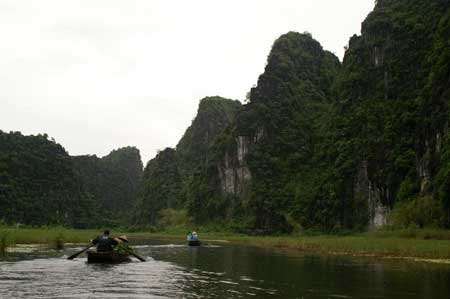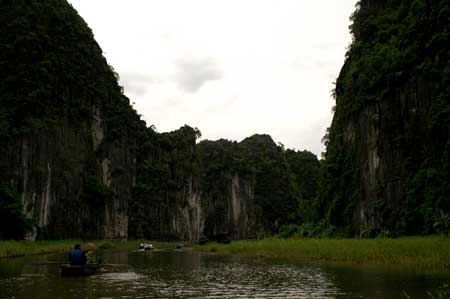Published Jun 30, 2006
So, if you’ve been following the weather in Southeast Asia — and, let’s face it, who doesn’t these days? — then you’ve probaby noticed that there was a typhoon in the South China Sea that turned and made its way over to North Vietnam, right where I am. Weather, on a vacation? Who’d’ve thunk it! So right now I’m sitting in my hotel room blogging, thanks to Typhoon Domeng. That means, and you get to learn all about my Typhoon-adjusted travels.
One of the trips I was most excited to take was the cruise around Ha Long Bay, a famous and scenic bay in Northern Vietnam. So, like a good tourist, I shopped around and booked a tour, and woke up early to pile onto a minibus and tool (rather slowly, since the Vietnamese drive at fairly low rates of speed) down a four-lane highway to Ha Long Bay. Nearly there, the tour guide turns around and tells us that the storm has closed down the bay. The whole minibus — except for the two Norweigans, who did not appear to respond in any meaningful way to any stimulus at all, even the one with the camera around his neck never bestirring himself to take a photo — was dejected as we turned around, although everyone also enjoyed the green bean cake candy that we got along the way back.
So, deposited back in Hanoi around mid-day, with time to kill and without one much-anticipated trip, I did two things:
- I booked a tour for the next day
- I visited Hoa Lo Prison
Hoa Lo was built at the end of the 19th century by the French administration. Like many of today’s prisons, it eventually became massively overcrowded; even before the overcrowding, however, the prison was still dank, light on facilities, and all prisoners were kept shackled most all of the day. There was a particularly effective display of the prison’s guillotine, with photos of heads in baskets after the use of said guillotine. I don’t know much about the history of prisons and how awful they were in general at the time, but it was clear that this was not a particularly pleasant prison to be in at any time. Later, the North Vietnamese used this prison to house American POWs, including John McCain; the propagandistic displays on this era decreased the effectiveness of the museum, because it’s clear that US POWs were treated badly, despite any statements otherwise; on the other hand, it’s impossible to assess how much better, or worse, the North Vietnamese were than the French, given the rather obviously silly nature of the more recent displays. The US POWs called the prison the Hanoi Hilton, which makes the brand-new high-rise hotel occuping 3/4 of the property a bit tasteless.
The next day, I took a tour of the area known as the “Ha Long Bay on land,” Tam Coc. Along the way we stopped at Hoa Lu, the capital of one of the first independent Viet states, in the 10th century. Two ancient temples are there, commemorating the two kings who ruled this brief state.

We also had a chance to see some of the traditional life in this rural community. Driving there, along a narrow road between rice paddies, was a beautiful way to see the backbreaking labor of agricultural workers in Vietnam’s countryside. Every house seemed to have a rice paddy in front, every community a large field of paddies, and each field was filled with coolies, planting and transplanting rice in their traditional conical hats, helped, in some places, by water buffalo, in others carrying their impediments on bicycles modified with long handlebars so that the bike could carry sacks while the person walks alongside.

Then it was down the Tam Coc river, which was quiet and serene, except for the occasional crowing cock, braying mountain goat, or vendor on riverboat offering sodas and woven products. Towers of stone thrust forth from the earth along both sides of the river, with lush jungle vegetation covering almost every surface. We paddled through three caves along the river, enjoying the quiet, still surface and the vistas. Naturally, the Vietnamese boat drivers didn’t keep to either side or make any effort to establish any pattern of navigation; it was every pilot for him (or her) self. Vendors trying to sell low-quality local handiwork and sodas paddled their own boats alone and caused many collisions as they ignored other boats to try to sell to tourists sitting on their boats. Hopefully, in the future, some order will be brought to the area; it was a drag, also, when our pilot tried to sell to us from a chest on his boat towards the end of the voyage. The fee for the voyage should cover the cost of the voyage, and I’d much rather enjoy the incredible beauty of the river in peace — because it was a remarkable, primeval place.


So, now my plane to Hué has been delayed for three hours, so I’m off to grab some Pho, or something similarly unthreatening. You see, I already had my challenging meal for breakfast — I sat down for what I took to be a poached egg and found, instead, that I was eating a chicken embryo, poached in its shell, and seasoned with fish sauce. Now, those of you who are familiar with Vietnames cuisine probably know that this local delicacy is what I should in fact have expected to come from a Vietnamese street vendor’s eggs, but, what can I say, I had my wonderful, strong, oily Vietnamese coffee after I bought the egg, not before. Frankly, I could live on that coffee — and maybe I’ll try!

“Towers of stone thrust forth from the earth along both sides of the river, with lush jungle vegetation covering almost every surface.”
you copied that from the tour guide booklet, didn’t you… :-)
sorry about your egg, that really sounds disgusting…but if they grow on ya, I know where you can get them here in Southern California.
Actually, it was really tasty. And the texture was inoffensive. Kind of like a very creamy, rich pudding. I’m not sure I need to have it again, but so long as I didn’t look too hard at it or think about what was in my mouth, then it was quite pleasant.